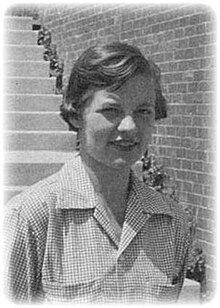Martha Chase
Martha Chase | |
|---|---|
 | |
| Born | Martha Cowles Chase November 30, 1927 |
| Died | August 8, 2003 (aged 75) Lorain, Ohio, USA |
| Other names | Martha C. Epstein |
| Alma mater | College of Wooster, University of Southern California |
| Known for | Hershey–Chase experiment |
| Scientific career | |
| Fields | Genetics, Biochemistry, Molecular Biology |
| Institutions | Cold Spring Harbor Laboratory, Oak Ridge National Laboratory, University of Rochester |
| Doctoral advisor | Giuseppe Bertani, Margaret Lieb |
Martha Cowles Chase (November 30, 1927 – August 8, 2003), also known as Martha C. Epstein,[1] was an American geneticist who in 1952, with Alfred Hershey, experimentally helped to confirm that DNA rather than protein is the genetic material of life.
Early life and college education
[edit]Chase was born in 1927 in Cleveland, Ohio.[1] Her father was a Western Reserve University Science Instructor and she grew up with her family in Cleveland Heights, Ohio.[2] After graduating from Cleveland Heights High School, she received a bachelor's degree from the College of Wooster in 1950, then worked as a research assistant before returning to school in 1959 and receiving a PhD in Microbiology from the University of Southern California in 1964.[3][4]
Research and later life
[edit]In 1950, Chase began working as a research assistant at Cold Spring Harbor Laboratory in the laboratory of bacteriologist and geneticist Alfred Hershey. In 1952, she and Hershey performed the Hershey–Chase experiment, which helped to confirm that genetic information is held and transmitted by DNA, not by protein. The experiment involved radioactively labeling either protein or nucleic acid of the bacteriophage T2 (a virus that infects bacteria) and seeing which component entered Escherichia coli upon infection. They found that nucleic acids but not protein were transferred, helping resolve controversy over the composition of hereditary information. Hershey won the Nobel Prize in Physiology or Medicine for the discovery in 1969, but Chase was not included.[1]
Chase left Cold Spring Harbor Laboratory in 1953 and worked with Gus Doermann at Oak Ridge National Laboratory in Tennessee, and later at the University of Rochester. Throughout the 1950s, she returned yearly to Cold Spring Harbor to take part in meetings of the Phage Group of biologists.[3] In 1959, she began doctoral studies at University of Southern California in the laboratory of Giuseppe Bertani. Bertani moved to Sweden and Chase finished her thesis with Margaret Lieb in 1964.[5]
While in California, Chase met and married fellow scientist Richard Epstein in the late 1950s and changed her name to Martha C. Epstein. The marriage was brief and they divorced shortly after with no children.[1] A series of personal setbacks through the 1960s ended her career in science. She moved back to Ohio to live with family and spent the last decades of her life suffering from a form of dementia that robbed her of short-term memory. She died of pneumonia on August 8, 2003, at the age of 75.[3]
Namesakes
[edit]The family Chaseviridae, a group of bacteriophages in order Caudovirales, was named in honor of Martha Chase.[6]
Key paper
[edit]- Hershey, A. D. and Martha Chase. "Independent Functions of Viral Protein and Nucleic Acid in Growth of Bacteriophage." J. Gen. Physiol., 36 (1): 39-56, September 20, 1952, at Oregon State University website
References
[edit]- ^ a b c d Dawson, Milly (2003-08-20). "Martha Chase dies". The Scientist. Retrieved 2010-09-25.
- ^ Baranick, Alana (August 14, 1998). "Martha Chase, 75, Cleveland native, worked on early DNA experiments". The Plain Dealer.
- ^ a b c Lavietes, Stuart (13 August 2003). "Martha Chase, 75, a Researcher Who Aided in DNA Experiment". The New York Times.
- ^ "Reactivation Of Phage-P2 Damaged By Ultraviolet Light :: University of Southern California Dissertations and Theses". digitallibrary.usc.edu. Retrieved 2018-03-12.
- ^ Illuminating life : selected papers from Cold Spring Harbor Laboratory, 1903-1969. Witkowski, J. A. (Jan Anthony), 1947-, Cold Spring Harbor Laboratory. Cold Spring Harbor, N.Y.: Cold Spring Harbor Laboratory Press. 2000. ISBN 9780879695668. OCLC 42462623.
{{cite book}}: CS1 maint: others (link) - ^ Evelien M. Adriaenssens, Mart Krupovic et al.: Taxonomy of prokaryotic viruses: 2018-2019 update from the ICTV Bacterial and Archaeal Viruses Subcommittee. In: Archives of Virology 165. 11 March 2020. Pp 1253–1260. doi:10.1007/s00705-020-04577-8. PDF
External links
[edit]- 1927 births
- 2003 deaths
- People from Shaker Heights, Ohio
- People from Cleveland Heights, Ohio
- American women biochemists
- American geneticists
- American women geneticists
- 20th-century American women scientists
- 20th-century American chemists
- College of Wooster alumni
- University of Southern California alumni
- 21st-century American women
- People with dementia
- Deaths from pneumonia in Ohio
- Biologists from Ohio
